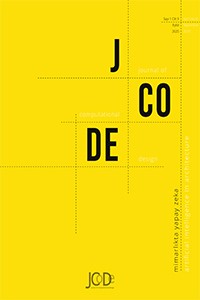Öz
Computer technologies have an important place in the fields of architecture and urban design as in every field today. It is possible to see that they are largely inspired by the life cycles of living organisms, when we look closely at the development processes of these technologies in the fields of architecture and urban design.
Slime mould which are examples of emerging living systems; shows an example of swarm intelligence, which arises from basic needs and produces results very different from individual behavior. Rail systems that significantly reduce the burden of today's urban transportation networks, are constantly changing and renewed, especially in large cities. When we look at the examples of which slime mould are used, it is seen that they have a very important role in the design of metro lines and highway systems.
In the article, it is aimed to evaluate an existing metro line by modeling slime mould behaviors with swarm intelligence approach in digital environment. Based on the studies conducted to evaluate the conformity of the metro lines and highways design criteria, this study will work on the Göztepe-Ümraniye metro line in Istanbul, which is still under construction. The stations on the line were kept constant and the model was expected to create a route, and the compliance of the route with the metro design criteria was evaluated. At points that do not comply with the design criteria, commands are introduced on the model via Python code, and the similarities and differences between the route created by the swarm and the existing route are compared.
Anahtar Kelimeler
Kaynakça
- Beni, G., Wang, J. (1990). Self-Organizing Sensor Systems. NATO ASI Series F: Computer and Systems Sciences. Vol. 58. (s. 251-261).
- Evangelidis, V., Jones, J., Dourvas, N., Tsompanas, M. A., Sirakoulis, G. Ch., Adamatzkya, A. (2017). Physarum machines imitating a Roman road network: the 3D approach. Scientific Reports.
- Hensel, M., Menges, A., Weinstock, M. (2004). Emergence: Morphogenetic Design Strategies. Argentina, Wiley.
- Hofstadter, D. (1979). Godel, Escher, Bach: An Eternal Golden Braid. New York. Basic Books.
- Jones, J. (2010). Characteristics of Pattern Formation and Evolution in Approximations of Physarum Transport Networks. Artificial Life Vol:16(s. 127-153).
- Toht, A., Nakagaki, T. (2000). Intelligence: Maze- Solving by an Amoeboid Organism. Nature: Volume 407.s.470-470.
- Url-7< https:// https://www.semanticscholar.org//>, 02.03.2020
- Url-8< https:// https://www.semanticscholar.org//>, 19.03.2020
Öz
Bilgisayar teknolojileri günümüzde her alanda olduğu gibi mimari ve kentsel tasarım alanlarında da önemli yer tutmaktadır. Bu teknolojilerin mimari ve kentsel tasarım alanlarında gelişim süreçlerine daha yakından bakıldığında büyük ölçüde canlı organizmaların yaşam döngülerinden esinlenildiğini görmek mümkündür.
Beliren canlı sistem örneklerinden olan cıvık mantarlar; temel ihtiyaçlarından doğan ve bireysel davranışlarından çok farklı sonuçlar doğuran sürü zekası örneği sergilemektedir. Günümüz kent içi ulaşım ağlarının yükünü önemli ölçüde hafifleten raylı sistemler, özellikle büyük kentlerde sürekli olarak değişmekte ve yenilenmektedir. Cıvık mantarların kullanıldığı örneklere bakıldığında, metro hatları ve otoyol sistemlerinin tasarımında oldukça önemli bir rolü olduğu görülmektedir.
Makalede sürü zekası yaklaşımı ile cıvık mantar davranışları sayısal ortamda modellenerek mevcut bir metro hatının değerlendirilmesi amaçlanmıştır. Metro hatlarının ve otoyolların tasarım kriterlerine uygunluğunu değerlendirmek için yapılan çalışmalardan yola çıkılarak, İstanbul kentinde yapımı devam etmekte olan Göztepe-Ümraniye metro hattı üzerinde çalışılmıştır. Hat üzerindeki istasyonlar sabit tutulup modelin bir güzergâh oluşturması beklenerek ve oluşan güzergahın metro tasarım kriterlerine uygunluğu değerlendirilmiştir. Tasarım kriterlerine uygunluk göstermeyen noktalarda model üzerinde Pyhton kodu aracılığı ile komutlar tanıtılıp, sürünün oluşturduğu güzergâh ile mevcut güzergâh arasındaki benzerlik ve farklılıklar karşılaştırılmıştır.
Anahtar Kelimeler
Kaynakça
- Beni, G., Wang, J. (1990). Self-Organizing Sensor Systems. NATO ASI Series F: Computer and Systems Sciences. Vol. 58. (s. 251-261).
- Evangelidis, V., Jones, J., Dourvas, N., Tsompanas, M. A., Sirakoulis, G. Ch., Adamatzkya, A. (2017). Physarum machines imitating a Roman road network: the 3D approach. Scientific Reports.
- Hensel, M., Menges, A., Weinstock, M. (2004). Emergence: Morphogenetic Design Strategies. Argentina, Wiley.
- Hofstadter, D. (1979). Godel, Escher, Bach: An Eternal Golden Braid. New York. Basic Books.
- Jones, J. (2010). Characteristics of Pattern Formation and Evolution in Approximations of Physarum Transport Networks. Artificial Life Vol:16(s. 127-153).
- Toht, A., Nakagaki, T. (2000). Intelligence: Maze- Solving by an Amoeboid Organism. Nature: Volume 407.s.470-470.
- Url-7< https:// https://www.semanticscholar.org//>, 02.03.2020
- Url-8< https:// https://www.semanticscholar.org//>, 19.03.2020
Ayrıntılar
| Birincil Dil | Türkçe |
|---|---|
| Konular | Mimarlık |
| Bölüm | Araştırma Makaleleri |
| Yazarlar | |
| Yayımlanma Tarihi | 30 Eylül 2020 |
| Yayımlandığı Sayı | Yıl 2020 Cilt: 1 Sayı: 3 |

JCoDe makaleleri "Creative Commons Attribution-NonCommercial 4.0 International License" altında yayınlanmaktadır.


